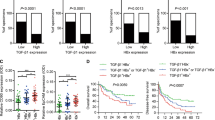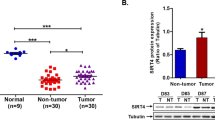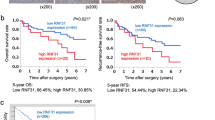Abstract
FAT10 is an oncogene that is localized at 6q21.3, a region frequently amplified in hepatocellular carcinoma (HCC). Recently, growing attention has been paid to its effect in the initiation of various cancers. However, there has been little research into the influence of FAT10 on the progression and prognosis of HCC, especially in hepatitis B virus (HBV)-related HCC. Here, we aimed at investigating clincopathological significance of FAT10 in HBV-related HCC and its underlying mechanisms. Based on the analysis of FAT10 expression in a reliable and large number of cases with 5-year follow-up, we showed that FAT10 was significantly increased in 260 samples from HBV-related HCC patients, compared with 30 normal tissue, 50 cirrhosis and matched adjacent nontumor tissues. FAT10 expression is correlated with recurrence and poor prognosis in HBV-related HCC. In addition, ectopic expression of FAT10 enhanced cell proliferation, inhibited apoptosis and induced cell cycle progression, whereas silencing FAT10 expression suppressed cell proliferation and induced apoptosis. FAT10 also induced the epithelial–mesenchymal transition (EMT) and promoted invasion of HCC cells. Furthermore, we found Akt/GSK3β pathway contributed to the effects of FAT10 in HCC cells. Blocking the Akt pathway significantly inhibited the actions of FAT10. Taken together, the ubiquitin-like protein FAT10 has a central role in regulating diverse aspects of the pathogenesis of HCC, indicating that it might be a potential therapeutic target.
This is a preview of subscription content, access via your institution
Access options
Subscribe to this journal
Receive 50 print issues and online access
$259.00 per year
only $5.18 per issue
Buy this article
- Purchase on Springer Link
- Instant access to full article PDF
Prices may be subject to local taxes which are calculated during checkout







Similar content being viewed by others
References
Thorgeirsson SS, Grisham JW . Molecular pathogenesis of human hepatocellular carcinoma. Nat Genet 2002; 31: 339–346.
Li JC, Yang XR, Sun HX, Xu Y, Zhou J, Qiu SJ et al. Up-regulation of Kruppel-like factor 8 promotes tumor invasion and indicates poor prognosis for hepatocellular carcinoma. Gastroenterology 2010; 139: e2112.
Yuen MF, Hou JL, Chutaputti A . Hepatocellular carcinoma in the Asia pacific region. J Gastroenterol Hepatol 2009; 24: 346–353.
Poon RT . Prevention of recurrence after resection of hepatocellular carcinoma: a daunting challenge. Hepatology 2011; 54: 757–759.
Fan W, Cai W, Parimoo S, Schwarz DC, Lennon GG, Weissman SM . Identification of seven new human MHC class I region genes around the HLA-F locus. Immunogenetics 1996; 44: 97–103.
Gruen JR, Nalabolu SR, Chu TW, Bowlus C, Fan WF, Goei VL et al. A transcription map of the major histocompatibility complex (MHC) class I region. Genomics 1996; 36: 70–85.
Canaan A, Yu X, Booth CJ, Lian J, Lazar I, Gamfi SL et al. FAT10/diubiquitin-like protein-deficient mice exhibit minimal phenotypic differences. Mol Cell Biol 2006; 26: 5180–5189.
Groettrup M, Pelzer C, Schmidtke G, Hofmann K . Activating the ubiquitin family: UBA6 challenges the field. Trends Biochem Sci 2008; 33: 230–237.
Dikic I, Wakatsuki S, Walters KJ . Ubiquitin-binding domains - from structures to functions. Nat Rev Mol Cell Biol 2009; 10: 659–671.
Kirkin V, Dikic I . Role of ubiquitin- and Ubl-binding proteins in cell signaling. Curr Opin Cell Biol 2007; 19: 199–205.
Hoeller D, Hecker CM, Dikic I . Ubiquitin and ubiquitin-like proteins in cancer pathogenesis. Nat Rev Cancer 2006; 6: 776–788.
Watson IR, Irwin MS, Ohh M . NEDD8 pathways in cancer, Sine Quibus Non. Cancer Cell 2011; 19: 168–176.
Bett JS, Kanuga N, Richet E, Schmidtke G, Groettrup M, Cheetham ME et al. The inherited blindness protein AIPL1 regulates the ubiquitin-Like FAT10 pathway. PLoS One 2012; 7: e30866.
Rani N, Aichem A, Schmidtke G, Kreft SG, Groettrup M . FAT10 and NUB1L bind to the VWA domain of Rpn10 and Rpn1 to enable proteasome-mediated proteolysis. Nat Commun 2012; 3: 749.
Ren J, Wang Y, Gao Y, Mehta SB, Lee CG . FAT10 mediates the effect of TNF-alpha in inducing chromosomal instability. J Cell Sci 2011; 124: 3665–3675.
Raasi S, Schmidtke G, Groettrup M . The ubiquitin-like protein FAT10 forms covalent conjugates and induces apoptosis. J Biol Chem 2001; 276: 35334–35343.
Zhang DW, Jeang KT, Lee CG . p53 negatively regulates the expression of FAT10, a gene upregulated in various cancers. Oncogene 2006; 25: 2318–2327.
Liu YC, Pan J, Zhang C, Fan W, Collinge M, Bender JR et al. A MHC-encoded ubiquitin-like protein (FAT10) binds noncovalently to the spindle assembly checkpoint protein MAD2. Proc Natl Acad Sci USA 1999; 96: 4313–4318.
Ren J, Kan A, Leong SH, Ooi LL, Jeang KT, Chong SS et al. FAT10 plays a role in the regulation of chromosomal stability. J Biol Chem 2006; 281: 11413–11421.
Lim CB, Zhang D, Lee CG . FAT10, a gene up-regulated in various cancers, is cell-cycle regulated. Cell Div 2006; 1: 20.
Qing X, French BA, Oliva J, French SW . Increased expression of FAT10 in colon benign, premalignant and malignant epithelial neoplasms. Exp Mol Pathol 2011; 90: 51–54.
Lee CG, Ren J, Cheong IS, Ban KH, Ooi LL, Yong Tan S et al. Expression of the FAT10 gene is highly upregulated in hepatocellular carcinoma and other gastrointestinal and gynecological cancers. Oncogene 2003; 22: 2592–2603.
Oliva J, Bardag-Gorce F, French BA, Li J, McPhaul L, Amidi F et al. Fat10 is an epigenetic marker for liver preneoplasia in a drug-primed mouse model of tumorigenesis. Exp Mol Pathol 2008; 84: 102–112.
Bardag-Gorce F, Oliva J, Li J, French BA, French SW . SAMe prevents the induction of the immunoproteasome and preserves the 26S proteasome in the DDC-induced MDB mouse model. Exp Mol Pathol 2010; 88: 353–362.
Lukasiak S, Schiller C, Oehlschlaeger P, Schmidtke G, Krause P, Legler DF et al. Proinflammatory cytokines cause FAT10 upregulation in cancers of liver and colon. Oncogene 2008; 27: 6068–6074.
Nejak-Bowen KN, Monga SP . Beta-catenin signaling, liver regeneration and hepatocellular cancer: sorting the good from the bad. Semin Cancer Biol 2011; 21: 44–58.
Gong P, Canaan A, Wang B, Leventhal J, Snyder A, Nair V et al. The ubiquitin-like protein FAT10 mediates NF-kappaB activation. J Am Soc Nephrol 2010; 21: 316–326.
Tommasi S, Pinto R, Pilato B, Paradiso A . Molecular pathways and related target therapies in liver carcinoma. Curr Pharm Des 2007; 13: 3279–3287.
Cheng GZ, Park S, Shu S, He L, Kong W, Zhang W et al. Advances of AKT pathway in human oncogenesis and as a target for anti-cancer drug discovery. Current Cancer Drug Targets 2008; 8: 2–6.
Carnero A . The PKB/AKT pathway in cancer. Current Pharmaceutical Design 2010; 16: 34–44.
Xia L, Huang W, Tian D, Zhu H, Zhang Y, Hu H et al. Upregulated FoxM1 expression induced by hepatitis B virus X protein promotes tumor metastasis and indicates poor prognosis in hepatitis B virus-related hepatocellular carcinoma. J Hepatol 2012; 57: 600–612.
Fu J, Chen Y, Cao J, Luo T, Qian YW, Yang W et al. p28GANK overexpression accelerates hepatocellular carcinoma invasiveness and metastasis via phosphoinositol 3-kinase/AKT/hypoxia-inducible factor-1alpha pathways. Hepatology 2011; 53: 181–192.
French SW . Molecular events in hepatic preneoplasia: a review. Exp Mol Pathol 2010; 88: 219–224.
Teufel A, Marquardt JU, Galle PR . Novel insights in the genetics of HCC recurrence and advances in transcriptomic data integration. J Hepatol 2011; 56: 279–281.
Wangsa D, Ryott M, Avall-Lundqvist E, Petersson F, Elmberger G, Luo J et al. Ki-67 expression predicts locoregional recurrence in stage I oral tongue carcinoma. Br J Cancer 2008; 99: 1121–1128.
Li QQ, Xu JD, Wang WJ, Cao XX, Chen Q, Tang F et al. Twist1-mediated adriamycin-induced epithelial-mesenchymal transition relates to multidrug resistance and invasive potential in breast cancer cells. Clin Cancer Res 2009; 15: 2657–2665.
Cooke VG, LeBleu VS, Keskin D, Khan Z, O'Connell JT, Teng Y et al. Pericyte depletion results in hypoxia-associated epithelial-to-mesenchymal transition and metastasis mediated by met signaling pathway. Cancer Cell 2012; 21: 66–81.
Rhim AD, Mirek ET, Aiello NM, Maitra A, Bailey JM, McAllister F et al. EMT and dissemination precede pancreatic tumor formation. Cell 2012; 148: 349–361.
Sabbah M, Emami S, Redeuilh G, Julien S, Prevost G, Zimber A et al. Molecular signature and therapeutic perspective of the epithelial-to-mesenchymal transitions in epithelial cancers. Drug Resistance Updates 2008; 11: 123–151.
Larue L, Bellacosa A . Epithelial-mesenchymal transition in development and cancer: role of phosphatidylinositol 3' kinase/AKT pathways. Oncogene 2005; 24: 7443–7454.
Wu D, Ding Y, Wang S, Zhang Q, Liu L . Increased expression of high mobility group box 1 (HMGB1) is associated with progression and poor prognosis in human nasopharyngeal carcinoma. J Pathol 2008; 216: 167–175.
Wu D, Chen L, Liao W, Ding Y, Zhang Q, Li Z et al. Fascin1 expression predicts poor prognosis in patients with nasopharyngeal carcinoma and correlates with tumor invasion. Ann Oncol 2010; 21: 589–596.
Chung JS, Park S, Park SH, Park ER, Cha PH, Kim BY et al. Overexpression of Romo1 promotes production of reactive oxygen species and invasiveness of hepatic tumor cells. Gastroenterology 2012; 143: 1084–94.e7.
Zou J, Luo H, Zeng Q, Dong Z, Wu D, Liu L . Protein kinase CK2alpha is overexpressed in colorectal cancer and modulates cell proliferation and invasion via regulating EMT-related genes. J Transl Med 2011; 9: 97.
Acknowledgements
This work was supported by the National Nature Science Foundation of China (Grant No. 81172056 and 81172586).
Author information
Authors and Affiliations
Corresponding authors
Ethics declarations
Competing interests
The authors declare no conflict of interest.
Additional information
Supplementary Information accompanies this paper on the Oncogene website
Supplementary information
Rights and permissions
About this article
Cite this article
Liu, L., Dong, Z., Liang, J. et al. As an independent prognostic factor, FAT10 promotes hepatitis B virus-related hepatocellular carcinoma progression via Akt/GSK3β pathway. Oncogene 33, 909–920 (2014). https://doi.org/10.1038/onc.2013.236
Received:
Revised:
Accepted:
Published:
Issue Date:
DOI: https://doi.org/10.1038/onc.2013.236
Keywords
This article is cited by
-
ARPC1A correlates with poor prognosis in prostate cancer and is up-regulated by glutamine metabolism to promote tumor cell migration, invasion and cytoskeletal changes
Cell & Bioscience (2023)
-
FAT10 promotes chemotherapeutic resistance in pancreatic cancer by inducing epithelial-mesenchymal transition via stabilization of FOXM1 expression
Cell Death & Disease (2022)
-
Construction of a ceRNA network and a genomic-clinicopathologic nomogram to predict survival for HBV-related HCC
Human Cell (2021)
-
Ubiquitin-like modifier FAT10 attenuates RIG-I mediated antiviral signaling by segregating activated RIG-I from its signaling platform
Scientific Reports (2016)
-
Upregulation of p-Smad2 contributes to FAT10-induced oncogenic activities in glioma
Tumor Biology (2016)



